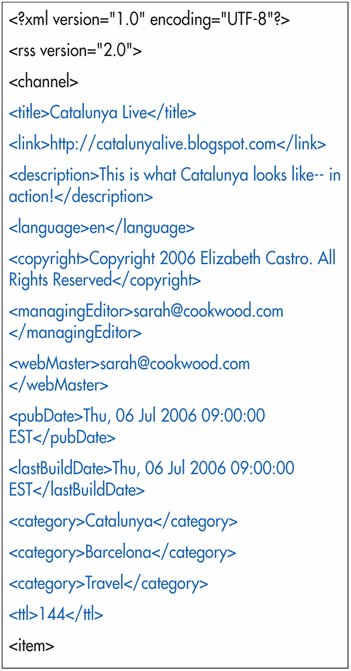| Once you've got the declarations done, you can work on the introductory section of your feed, the part that describes your Web site. Figure 25.5. The elements that describe your RSS feed go between the opening <channel> element and the first <item> element (which we'll get to in the next section). 
To describe your site: 1. | After the opening <channel> tag that you created in step 6 on page 379, type <title>Web Site</title>, where Web site is the name of your site.
| 2. | Next, type <link>url</link>, where url is the location of your Web site.
| 3. | Type <description>about site</description>, where about site describes the Web site.
| | | 4. | If desired, add additional descriptive elements. In each case, use the syntax <tag>content</tag>.
Use <language> to advise prospective readers what language your content is in. Use the two-letter code listed in http://www.rssboard.org/rss-language-codes. English is en.
Use <copyright> to declare the rights restrictions for your content.
Use <managingEditor> to give the email of the person who is in charge of content.
Use <webMaster> to give the email address of the person in charge of technical issues regarding your site.
Use <pubDate> for the official publication date of your content, like the dateline on a newspaper article. The date must be in RFC-822 format (see the third tip).
Use <lastBuildDate> to specify the actual date and time the content was last updated, in RFC-822 format (again, see the third tip).
Use <category> to help aggregators classify your feed and make it easier for folks to find you (but see sidebar).
Use <ttl> (which stands for time to live) to indicate how frequently you are most likely to update it and thus how often the aggregator should come back and refresh.
| 5. | Create the item elements as described on pages 382383.
|
About RSS Categories As far as I can tell, there's no "official" list of categories to choose from when describing your RSS feed with the category element. Indeed, the only aggregator that I have found that pays attention to categories at all is iTunes, but it uses a different syntax (that we'll discuss on pages 388391). |
 Tips Tips
Only the title, link, and description elements are absolutely required. Specifying the additional descriptive elements helps prospective visitors find you. The date in pubDate and lastBuildDate should be in the form Mon, 23 Apr 2007 11:15:01 EST. The day of the week is optional but if present, should be abbreviated to three letters and in English. The month is required and should also be in English and abbreviated to 3 letters. The seconds are optional. The time zone must be one of UT, GMT, EST, EDT, CST, CDT, MST, MDT, PST, PDT, or military abbreviations, or can be specified by a plus or minus sign plus the difference in hours and minutes from GMT: -0800. You can find the full specification by Googling RFC 822. There are several more elements that can go in your RSS feed (inside the channel element) but aren't widely used or supported. These are: generator, docs, image, cloud, skipHours, skipDays, rating, textInput. You can find more information about them, along with the full RSS 2.0 specification, at http://www.rssboard.org/rss-specification.
|

 Tips
Tips